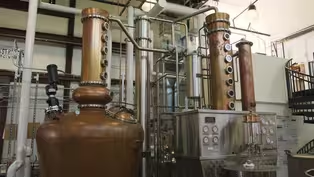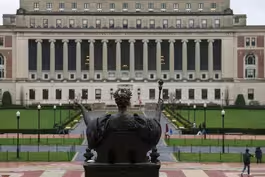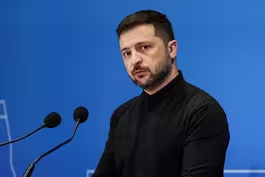
How Ben & Jerry’s is recycling food waste into energy
Clip: 7/28/2025 | 7m 4sVideo has Closed Captions
How Ben & Jerry’s is recycling food waste into energy
It may sound like the stuff of sci-fi movies, but diverting food waste from the landfill and converting it into electricity has become a real thing. William Brangham visited Ben & Jerry’s Vermont ice cream factory and the operations next door to find out how it works.
Problems playing video? | Closed Captioning Feedback
Problems playing video? | Closed Captioning Feedback
Major corporate funding for the PBS News Hour is provided by BDO, BNSF, Consumer Cellular, American Cruise Lines, and Raymond James. Funding for the PBS NewsHour Weekend is provided by...

How Ben & Jerry’s is recycling food waste into energy
Clip: 7/28/2025 | 7m 4sVideo has Closed Captions
It may sound like the stuff of sci-fi movies, but diverting food waste from the landfill and converting it into electricity has become a real thing. William Brangham visited Ben & Jerry’s Vermont ice cream factory and the operations next door to find out how it works.
Problems playing video? | Closed Captioning Feedback
How to Watch PBS News Hour
PBS News Hour is available to stream on pbs.org and the free PBS App, available on iPhone, Apple TV, Android TV, Android smartphones, Amazon Fire TV, Amazon Fire Tablet, Roku, Samsung Smart TV, and Vizio.
Providing Support for PBS.org
Learn Moreabout PBS online sponsorshipAMNA NAWAZ: It may sound like the stuff of sci-fi movies, but diverting food waste from the landfill and converting it into electricity has become a real thing, and that conversion can help reduce climate change.
William Brangham recently visited a Vermont ice cream factory and the operations next door to find out how it works.
WILLIAM BRANGHAM: At the Ben and Jerry's ice cream plant in St. Albans, Vermont, they can churn out over 100 million pints of ice cream a year.
And to assemble each of their dozens of different flavors, there are precise amounts of added cream, some chocolate perhaps, or maybe chocolate chips.
But key to the whole operation is keeping those distinct flavors separate.
JENNA EVANS, Ben and Jerry's: Say you are making Chunky Monkey in the factory, and then the next flavor comes up and it's Cherry Garcia.
You don't want to mix Chunky Monkey with Cherry Garcia.
WILLIAM BRANGHAM: Jenna Evans is Ben and Jerry's global sustainability manager.
JENNA EVANS: When you push one flavor out with a little bit of rinse water, that extra flavor that was left over in the pipes gets pushed into a barrel that gets stored as a waste ice cream product.
WILLIAM BRANGHAM: Once that waste is collected, Ben and Jerry's has to figure out what to do with it.
ERIC ROY, University of Vermont: Historically, many organic wastes have been sent to landfills, especially food waste.
WILLIAM BRANGHAM: Eric Roy is an ecological engineer at the University of Vermont.
ERIC ROY: Once that food waste ends up in a landfill, it can produce methane that can escape to the atmosphere.
And when that happens, that contributes to climate change.
Methane is a potent greenhouse gas.
WILLIAM BRANGHAM: It turns out there's an alternative process that works a lot like our own bodies do when we eat.
It's called anaerobic digestion.
ERIC ROY: We eat food and it is processed in our gut.
In this case, we're feeding the food waste to a large constructed gut that's full of microbial life, and that microbial life is digesting the material and turning it into methane gas, which we can then capture and use as an energy source.
WILLIAM BRANGHAM: Right next door to the Ben and Jerry's plant in those shining steel towers is a new anaerobic digester, one of over 2,000 nationwide.
ERIC FITCH, Founder & CEO, PurposeEnergy: This facility receives up to 50,000 gallons a day of waste.
WILLIAM BRANGHAM: PurposeEnergy CEO Eric Fitch says most of that waste is pumped directly from the Ben and Jerry's facility.
ERIC FITCH: The wastewater goes into these big tanks with bioreactors.
Inside the bioreactors, there are bacteria that just metabolize whatever we're feeding it.
JUSTIN FILIAULT, PurposeEnergy: This is our raw influent, what we're feeding into our digester now, very dirty, nasty looking water.
WILLIAM BRANGHAM: Justin Filiault is a wastewater operator at PurposeEnergy.
JUSTIN FILIAULT: So, in our digesters, this is what it looks like.
That's just the color of our bacteria.
WILLIAM BRANGHAM: So this is sort of a microcosm of what's happening in the huge tanks out there.
JUSTIN FILIAULT: Yes.
And the little air bubbles you see in there are then producing methane.
WILLIAM BRANGHAM: The digestion process produces methane and carbon dioxide, which if allowed to just leave the reactor would contribute to climate change, but when captured and used is called biogas.
ERIC FITCH: The biogas comes off the top and then it goes into this container over here that has a big engine in it.
The engine turns a big generator that produces electricity, goes through a transformer and out to the grid.
WILLIAM BRANGHAM: How much electricity?
ERIC FITCH: This system puts out a little over a megawatt, which is about enough to power 1,300 homes in Vermont.
WILLIAM BRANGHAM: Another byproduct of this process, cleaner water.
ERIC FITCH: In the inside of here, these are packed with filters.
WILLIAM BRANGHAM: Here, leftover particulate matter is removed from the water.
ERIC FITCH: There's really no contaminant left in the process after it's gone through the filter.
WILLIAM BRANGHAM: The water then goes to the local community's water treatment plant.
JUSTIN FILIAULT: This is what it looks like that we're shipping out to the town.
We remove over 99 percent of all the particles and contaminants in it.
WILLIAM BRANGHAM: The digester also produces these phosphorus-rich solids.
ERIC FITCH: We call this a natural soil amendment.
All of that phosphorus that comes into our plant from the concentrated food waste, we coagulate it with an iron salt, and it makes this iron phosphate.
We take it even to our house and put it in our garden.
WILLIAM BRANGHAM: This is actually a useful product now for agriculture.
ERIC FITCH: Yes, exactly.
You can use this the same way you would use manure or some other commercial fertilizer.
ERIC ROY: It looks like compost.
WILLIAM BRANGHAM: At Eric Roy's lab, they're studying the solids produced by the St. Albans digester.
ERIC ROY: Looking at how much of the essential nutrients for plants exist in this material and how that compares to more familiar materials for farmers.
WILLIAM BRANGHAM: Farmers are familiar with manure, but this so-called digestate is relatively unknown.
ERIC ROY: The goal is to try to produce useful fertilizers and also inform best practices for how to use it, because if nutrients aren't used properly, they can run off to the water and cause environmental problems.
WILLIAM BRANGHAM: In fact, helping the environment is a key reason Ben and Jerry's sends waste to the anaerobic digester.
They want to lower that phosphorus pollution.
JENNA EVANS: Lake Champlain gets algae blooms a lot in the summer and that's to due phosphorus loading in waterways.
And dairy inherently has phosphorus in it.
And so we want to make sure that the phosphorus is not getting into the watershed.
WILLIAM BRANGHAM: And by piping waste to the digester, Ben and Jerry's reduced its carbon footprint.
JENNA EVANS: We were sending over 600 trucks a year out on the highways going all across New England to dispose of this waste.
So we're eliminating hundreds of trips there and back.
WILLIAM BRANGHAM: But when it comes to the environment, the process isn't perfect, even if it's greener than using landfills.
For instance, converting that gas to energy still does release some air pollution.
But here in Vermont, there's another reason to use an anaerobic digester.
ERIC ROY: It is illegal right now in the state of Vermont to dispose of organic material like food waste, kitchen scraps, into a trash bin that will go to the landfill.
WILLIAM BRANGHAM: Illegal?
ERIC ROY: Yes, enforcement's always a question with policies like this, but technically everybody is legally required to send their food waste to some sort of processing strategy.
WILLIAM BRANGHAM: Of course, anaerobic digestion isn't the only strategy.
Many people compost their food waste.
Roy's research on both is under peer review.
ERIC ROY: We looked at what are the greenhouse gas reduction benefits associated with moving the U.S. more towards a Vermont-like policy, where material goes to composting or anaerobic digestion.
And it's well over an 80 percent reduction in greenhouse gas emissions from food waste management.
WILLIAM BRANGHAM: Meanwhile, the rest of us can keep digesting Ben and Jerry's in our own way.
For the "PBS News Hour," I'm William Brangham.
AMA president warns against preventive services panel cuts
Video has Closed Captions
Clip: 7/28/2025 | 6m 34s | AMA president warns against preventive services task force cuts (6m 34s)
Distillery blends local flavors to create unique spirits
Video has Closed Captions
Clip: 7/28/2025 | 4m 50s | Rhode Island distillery blends local flavors to create unique spirits (4m 50s)
EU ambassador breaks down implications of U.S. trade deal
Video has Closed Captions
Clip: 7/28/2025 | 9m 7s | EU ambassador breaks down implications of U.S. trade deal: 'We know where we are going' (9m 7s)
Examining Trump's approach to combat antisemitism on campus
Video has Closed Captions
Clip: 7/28/2025 | 6m 19s | A look at 'Project Esther' and Trump's approach to combat antisemitism on campus (6m 19s)
News Wrap: Trump moves up his deadline for Putin to end war
Video has Closed Captions
Clip: 7/28/2025 | 6m 49s | News Wrap: Trump moves up his deadline for Putin to end Ukraine war (6m 49s)
Tamara Keith and Jasmine Wright on Trump's trade deals
Video has Closed Captions
Clip: 7/28/2025 | 8m 32s | Tamara Keith and Jasmine Wright on Trump's trade deals and the economy (8m 32s)
Trump says he sees 'real starvation' in Gaza
Video has Closed Captions
Clip: 7/28/2025 | 3m 27s | Trump urges Israel to allow food into Gaza as he sees 'real starvation' there (3m 27s)
Providing Support for PBS.org
Learn Moreabout PBS online sponsorshipSupport for PBS provided by:
Major corporate funding for the PBS News Hour is provided by BDO, BNSF, Consumer Cellular, American Cruise Lines, and Raymond James. Funding for the PBS NewsHour Weekend is provided by...


















